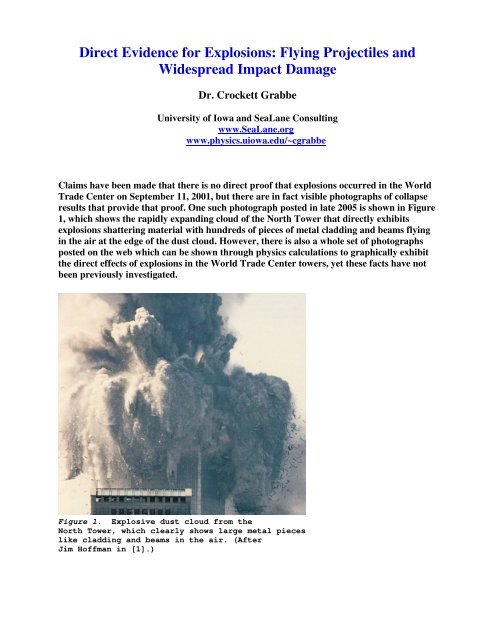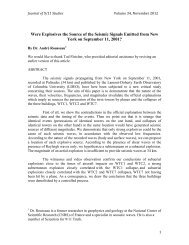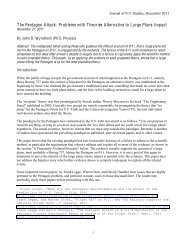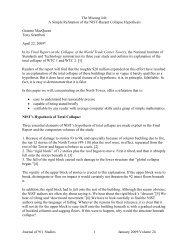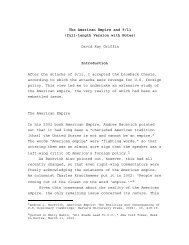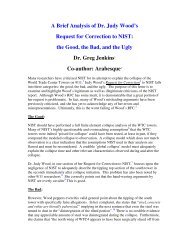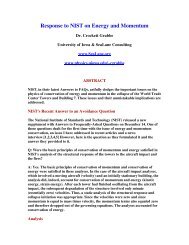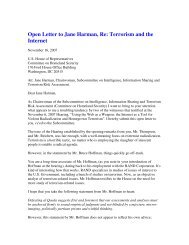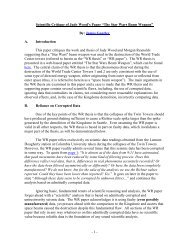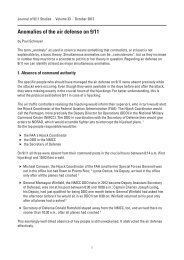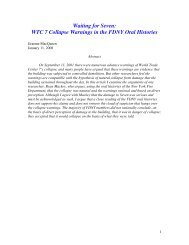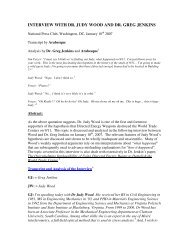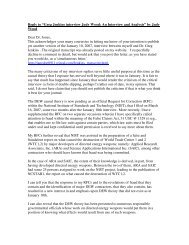Direct Evidence for Explosions - Journal of 9/11 Studies
Direct Evidence for Explosions - Journal of 9/11 Studies
Direct Evidence for Explosions - Journal of 9/11 Studies
You also want an ePaper? Increase the reach of your titles
YUMPU automatically turns print PDFs into web optimized ePapers that Google loves.
<strong>Direct</strong> <strong>Evidence</strong> <strong>for</strong> <strong>Explosions</strong>: Flying Projectiles and<br />
Widespread Impact Damage<br />
Dr. Crockett Grabbe<br />
University <strong>of</strong> Iowa and SeaLane Consulting<br />
www.SeaLane.org<br />
www.physics.uiowa.edu/~cgrabbe<br />
Claims have been made that there is no direct pro<strong>of</strong> that explosions occurred in the World<br />
Trade Center on September <strong>11</strong>, 2001, but there are in fact visible photographs <strong>of</strong> collapse<br />
results that provide that pro<strong>of</strong>. One such photograph posted in late 2005 is shown in Figure<br />
1, which shows the rapidly expanding cloud <strong>of</strong> the North Tower that directly exhibits<br />
explosions shattering material with hundreds <strong>of</strong> pieces <strong>of</strong> metal cladding and beams flying<br />
in the air at the edge <strong>of</strong> the dust cloud. However, there is also a whole set <strong>of</strong> photographs<br />
posted on the web which can be shown through physics calculations to graphically exhibit<br />
the direct effects <strong>of</strong> explosions in the World Trade Center towers, yet these facts have not<br />
been previously investigated.<br />
Figure 1. Explosive dust cloud from the<br />
North Tower, which clearly shows large metal pieces<br />
like cladding and beams in the air. (After<br />
Jim H<strong>of</strong>fman in [1].)
Photographs <strong>for</strong> the case that I claim clearly provide pro<strong>of</strong> that multiple explosions<br />
occurred, but have never been presented as such, are shown in Figures 2 and 3. The figures<br />
show cases <strong>of</strong> unmistakable evidence <strong>of</strong> damage from the World Trade Center collapses.<br />
These are just 2 examples <strong>of</strong> many cars that were pelted and devastated by such material<br />
from the collapsing World Trade Center buildings. Photos <strong>of</strong> many <strong>of</strong> these cars were<br />
posted by Pr<strong>of</strong>. Judy Wood, who claims that they show damage from directed-energy laserbeam<br />
weapons. The laser-beam proposal was strongly challenged recently, although<br />
without proposing alternative models. Neither described the cause examined here. [2,3]<br />
Figure 2. Vehicle damaged by World<br />
Trade Center explosions. (From [2].)<br />
Note that the uneven bending and<br />
twisting <strong>of</strong> metal, shattered windows,<br />
and swath <strong>of</strong> surface damage over a<br />
large area <strong>of</strong> metal. This combination<br />
<strong>of</strong> damage strongly suggests it was hit<br />
with <strong>for</strong>ce by a wide stream <strong>of</strong> debris<br />
which was apparently hot and possibly<br />
corrosive to the metal. This car was<br />
located on FDR Drive, and (reference<br />
[4]) was evidently towed to that<br />
location.<br />
Figure 3. Vehicle damaged by World<br />
Trade Center explosions posted in<br />
reference [2]. The material caked on<br />
the exterior as well present inside<br />
the car apparently came from debris<br />
material streaming at high-speeds,<br />
shattering the windows. The seat has<br />
some projectile material on it, but<br />
was largely undamaged, probably<br />
because the car metal shielded it from<br />
any direct hit. The vehicle does not<br />
exhibit fire or heat damage.<br />
The video frame in Figure 4 <strong>of</strong> the World Trade Center North Tower taken by KTLA<br />
channel 5 news shows a "squib" -- a line <strong>of</strong> ejecting material from the tower -- right be<strong>for</strong>e<br />
it collapsed. Such squib ejections are driven by massive overpressure inside the building<br />
relative to the atmospheric pressure outside, and that overpressure is created by<br />
explosions. A number <strong>of</strong> squibs were observed coming from all 3 <strong>of</strong> Buildings 1, 2, and 7 a<br />
short second or 2 after each one started to collapse, and there are several websites that<br />
show photograph <strong>of</strong> them on all 3 buildings. The one displayed as Figure 4 shows ejecting<br />
material (bits <strong>of</strong> material large enough to have little air resistance) streaming out <strong>of</strong> the<br />
North Tower, which has traveled a distance from the tower in the horizontal direction,<br />
whereas the distance it has descended in the vertical direction because <strong>of</strong> gravitation pull is<br />
small.
Figure 4. Photograph from a video <strong>of</strong><br />
the North Tower collapse by KTLA channel 5<br />
news, which shows a streaming squib that has<br />
traveled out over 70 feet from the tower with<br />
very little descent [5].<br />
Note the quantitative in<strong>for</strong>mation that can be gathered from the ejection photograph in<br />
Figure 4. We can estimate that, at the front end, the ejecting plume has apparently fallen<br />
no more than roughly 3 feet (an estimate that might have up to a factor <strong>of</strong> 2 in error),<br />
whereas the horizontal distance <strong>of</strong> the front from building is about 1/3 the width <strong>of</strong> the<br />
North Tower, or about 70 feet. If we neglect air friction resistance over the length <strong>of</strong> the<br />
streamer, from fall distance s=0.5gt 2 , where g=32 feet/sec 2 is the gravitational acceleration,<br />
we estimate 0.43 sec as the time since the front end first ejected from the building. That<br />
means that material in that squib is traveling horizontally at roughly 163 feet/sec, which<br />
means the squibs are effectively "bullets" <strong>of</strong> bits <strong>of</strong> material produced by the explosions.<br />
Since the distance fallen is quite small there may be a fairly large uncertainly in its<br />
estimate. Allowing <strong>for</strong> an error <strong>of</strong> up to a factor <strong>of</strong> 2 in the measurement <strong>of</strong> the fall distance<br />
s, the velocity could be down to 41% lower or up to 30% higher, so it could range from 100<br />
feet/s to over 200 feet/s.<br />
The mechanics <strong>of</strong> the motion can be examined to determine where the debris in the ejection<br />
plume hits the ground. At such high velocities air resistance can actually be an important<br />
factor in that distance, so it is incumbent on us to examine the mechanical equations <strong>of</strong> the
squib ejections like Figure 4 with those terms included. Thus in the ejection the downward<br />
acceleration is given by:<br />
(1) a = dv/dt = g - α v 2 .<br />
where the Rayleigh drag coefficient <strong>for</strong> objects at high velocity v is:<br />
(2) α = ρ AC d /2m<br />
where ρ is the air density = 1.293 kg/m 3 at 1 atmosphere pressure and 0 o C, A is the area at<br />
the front <strong>of</strong> the moving material in the plume, m the material's mass, and C d is a<br />
dimensionless drag coefficient. C d can be 0.25 <strong>for</strong> sleek automobiles, and will taken as 0.5 in<br />
our calculations. Note that this can be rewritten in terms <strong>of</strong> the ratio <strong>of</strong> air density to the<br />
density <strong>of</strong> the ejected material by designating l as the typical length <strong>of</strong> the ejected<br />
projectile, as:<br />
(3) α = (ρ air /ρ eject ) C d /2ml<br />
A table below summarizes some typical values <strong>of</strong> α <strong>for</strong> various material parameters.<br />
Table: Values <strong>of</strong> α <strong>for</strong> selected material parameters<br />
material α l<br />
cement, glass<br />
steel<br />
0.001 5 in<br />
0.003 1.5 in<br />
0.01 0.5 in<br />
0.001 1.7 in<br />
0.003 0.6 in<br />
0.01 0.2 in<br />
Solving (1) <strong>for</strong> v(t) by separation <strong>of</strong> variables yields the downward velocity v d and<br />
downward distance y:<br />
(4) v d (t)= (g/α ) 1/2 tanh [(g α ) 1/2 t]<br />
(5) y(t) = (1/α) ln cosh [(g α ) 1/2 t]<br />
So where does this squib material hit the ground If we take y to be the height <strong>of</strong> the<br />
ejection, we can solve the last equation <strong>for</strong> t, the time the material remains in the air.<br />
Multiply that t by the horizontal velocity v h <strong>of</strong> the squib material, and we have the<br />
horizontal distance x it travels. The equation <strong>of</strong> motion <strong>for</strong> the horizontal movement <strong>of</strong> the<br />
material is:<br />
(6) a = dv/dt = - α v 2
which solves by separation <strong>of</strong> variables, yielding:<br />
(7) v h (t)= v o /(1 + α v o t)<br />
(8) x(t) = (1/α) ln (1 + α v o t)<br />
where v o is the velocity <strong>of</strong> initial ejection from the tower. Taking t to be the time the<br />
material remains in the air from (5) (solving <strong>for</strong> t after setting y=h) gives x(t) = xhit, the<br />
distance the material travels away from the tower. Graphs <strong>of</strong> that distance xhit versus the α<br />
<strong>for</strong> the material are shown in Figures 5 and 6 <strong>for</strong> ejections from about 1304 feet (400<br />
meters) and 489 feet (150 m).<br />
Figure 5. Graph <strong>of</strong> the horizontal<br />
distance the squib material travels<br />
from the center (xhit) as a function<br />
<strong>of</strong> the air resistivity α , assuming it<br />
hits no invervening object (e.g.<br />
another building) be<strong>for</strong>e hitting at<br />
the ground level. The height <strong>of</strong> the<br />
squib origin in the tower is taken as<br />
1304 feet (400 m, a feasible height<br />
<strong>for</strong> the North Tower).<br />
Figure 6. Graph <strong>of</strong> the distance the<br />
squib travels from the center (xhit)<br />
versus <strong>of</strong> the air resistivity α <strong>of</strong> the<br />
squib.<br />
The height <strong>of</strong> the squib origin in the<br />
tower is taken as 489 feet (150 m, a<br />
feasible height on WTC7).<br />
Figures 5 and 6 show these high-speed squibs shot out material up to 1/4 mile or more from<br />
the towers. This ejection distance xhit is not all that sensitive to the height <strong>of</strong> origin: raising<br />
or lowering the ejection height by over 800 feet changes xhit by less than 500 feet <strong>for</strong> the<br />
low resistivity side, and just over 200 feet on the high resistivity side. Similarly, I found that
lowering the ejection velocity v o by 25% lowers xhit by around 200 feet on the low<br />
resistivity side, and less than 100 feet on the high resistivity side. The debris material would<br />
clearly be spread over a substantial area (40 acres or more) depending its ejection velocity,<br />
its content, and how fine it was broken up when it was ejected, since several such squibs in<br />
all directions were observed. Furthermore, it is likely that explosions are also occurring<br />
after the growing dust cloud envelopes the area (e.g., higher up on the North Tower in Fig.<br />
4), so squibs producing all <strong>of</strong> that ejected material would not have been observed. This high<br />
speed material would likely damage whatever it hit on the ground, if it did not hit and<br />
damage a building be<strong>for</strong>e reaching the ground level. Figures 2 and 3 show examples <strong>of</strong> such<br />
damage when it hit vehicles at the ground level.<br />
Reference [2] reports that around 1400 cars were seriously damaged like those in Figures 2<br />
and 3. Some <strong>of</strong> the damage was because <strong>of</strong> fires started by ejections from the towers, since<br />
a number <strong>of</strong> cars were not in direct line <strong>of</strong> fire <strong>of</strong> the towers, but many were also hit at high<br />
speeds with debris. Clearly multiple explosions would be necessary to produce this damage.<br />
The damage is not likely be produced by laser directed-energy beam weapons as Judy<br />
Wood and Morgan Reynolds theorize, since the nature <strong>of</strong> destruction in that case clearly<br />
would be different: there would be evidence <strong>of</strong> melting <strong>of</strong> metal, likely burning into or<br />
through the metal, and burning <strong>of</strong> tires, but there would not be most <strong>of</strong> the surface impacts<br />
and bending and twisting <strong>of</strong> metal observed. If the tire in Figure 2 was burned <strong>of</strong>f by a<br />
laser there would likely also be evidence <strong>of</strong> laser damage to the rim. Laser damage is quite<br />
inconsistent with that <strong>of</strong> the vehicle in Figure 3, which exhibits shattered windows with no<br />
melting or burning on the exterior surface or the inside seat, and corroded material in the<br />
rear.<br />
The damage to these vehicles was most likely from being hit by a large swath <strong>of</strong> small highspeed<br />
objects <strong>of</strong> material that may have been hot and/or somewhat corrosive in nature.<br />
Many damaged vehicles, such as the one in Figure 2, show evidence <strong>of</strong> being scorched or<br />
burned by inflamed material, and both Figures 2 and 3 show possible corrosion. The<br />
windows in both vehicles were shattered, just like they were in many vehicles and in nearby<br />
buildings. It should also be noted that, similar to Figure 2, many <strong>of</strong> the vehicles clearly<br />
show damage primarily on one side or on part <strong>of</strong> the vehicle. Furthermore, photos also<br />
show shattered windows and other directed-damage in buildings <strong>for</strong> some distance from<br />
the base <strong>of</strong> the towers. This is good evidence <strong>of</strong> that the nearby vehicles and buildings were<br />
hit by "directed-energy weapons" from the tower. However, that directed energy came<br />
from the material shot out from the tower at high velocity because <strong>of</strong> explosions, rather<br />
than postulated sources like laser-beam weapons. The shattered windows and apparent<br />
impact damage in both cases provide strong evidence <strong>of</strong> being hit by material from<br />
explosives.<br />
In summary, a number <strong>of</strong> photographs show the destructive impacts <strong>of</strong> explosions on many<br />
vehicles, such as those <strong>of</strong> Figure 2 and 3, as well as on a several nearby buildings in the<br />
vicinity <strong>of</strong> the towers. Calculations using a range <strong>of</strong> estimates from observations show the<br />
destruction from these explosions range up to 1/4 mile or more in most directions. These<br />
strongly enhance the evidence presented in previous studies, such the photo in Figure 1<br />
which shows the rapidly expanding huge dust clouds from the towers resulting from
massive pulverization <strong>of</strong> the non-metallic parts <strong>of</strong> the towers in mid-air, along with<br />
hundreds <strong>of</strong> pieces <strong>of</strong> metal cladding and beams flying through the air on their rim. All <strong>of</strong><br />
them provide dramatic examples <strong>of</strong> the devastation <strong>of</strong> the explosions in the World Trade<br />
Center towers 6 years ago.<br />
References<br />
1. Jim H<strong>of</strong>fman, "Building a Better Mirage," 12/8/2005, posted at<br />
http://9<strong>11</strong>research.wtc7.net/essays/nist<br />
2. Judy Wood and Morgan Reynolds, "Star Wars Beam Weapon" section on "Toasted<br />
Cars", posted at http://drjudywood.com/articles/DEW/StarWarsBeam5.html<br />
3. Gregory Jenkins, "The Overwhelming Implausibility <strong>of</strong> Using <strong>Direct</strong>ed Energy Beams to<br />
Demolish the World Trade Center" <strong>Journal</strong> <strong>of</strong> 9<strong>11</strong> <strong>Studies</strong>, Vol. 8, Feb., 2007. (Posted at<br />
http://www.<strong>Journal</strong><strong>of</strong>9<strong>11</strong><strong>Studies</strong>.com)<br />
4. James Gourley, "Scientific Critique on Judy Wood's paper 'The Star Wars Beam<br />
Weapon'" Letters to the <strong>Journal</strong> <strong>of</strong> 9<strong>11</strong> <strong>Studies</strong>, Jan., 2007. (Posted at<br />
http://www.<strong>Journal</strong><strong>of</strong>9<strong>11</strong><strong>Studies</strong>.com)<br />
5. First photograph in 9-<strong>11</strong> Research, "Squibs" posted at<br />
http://9<strong>11</strong>research.wtc7.net/wtc/analysis/collapses/squibs.html


